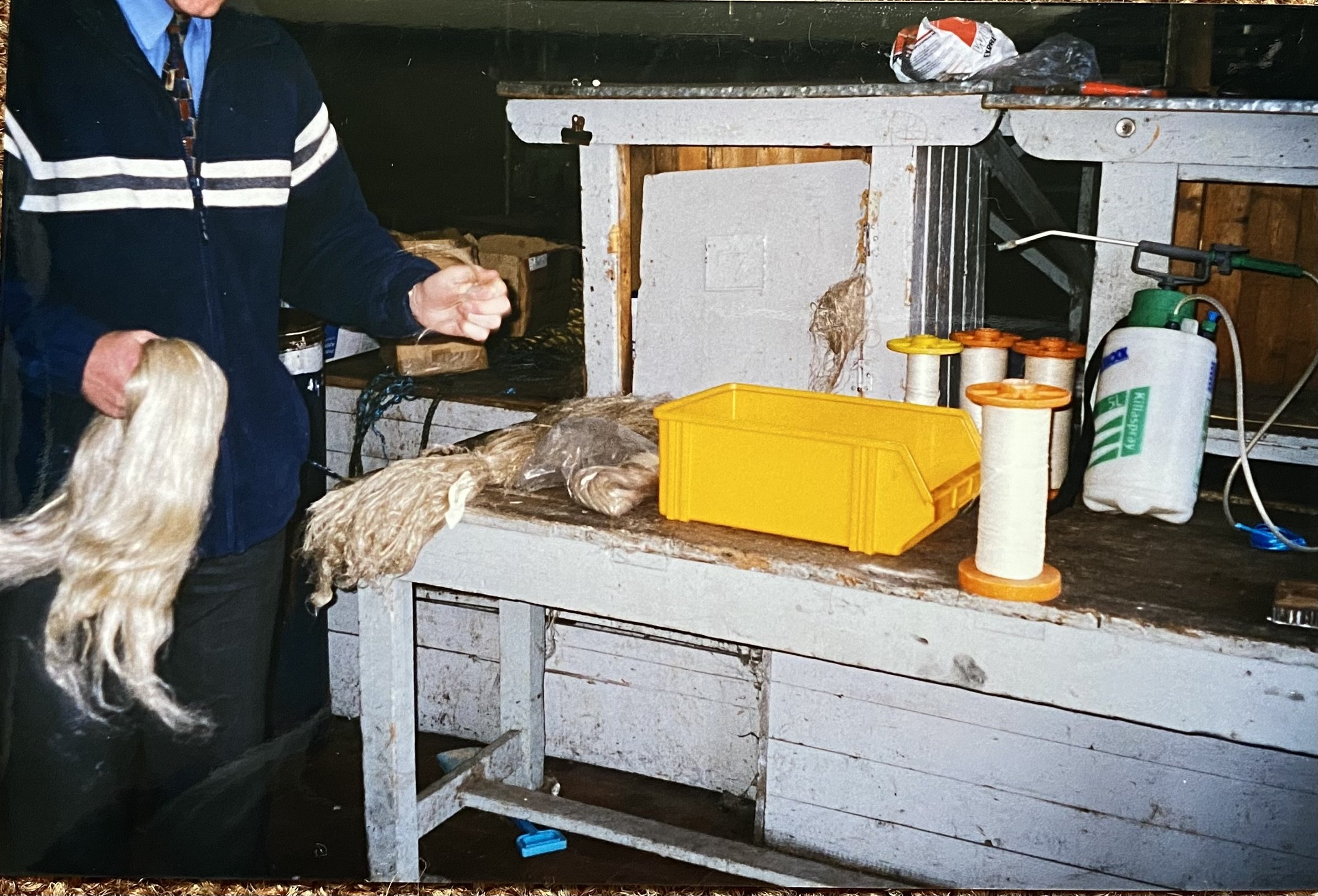Linenopolis
- Brenda Anderson with Swatch Books at Blackers Mill, Portadown
Belfast became the dominating city of fabric production in the British Isles during the late 1700s. The nickname of ‘Linenopolis’ was bestowed on Belfast due to its flourishing linen trade.
The heyday of the once powerful Ulster linen industry and those who ran it is recalled in a publication written by Dr Kathleen Rankin, titled “The Linen Houses of the Lagan Valley”. It tells the story of the families whose fortunes were made from the manufacture of linen yarn and cloth. It recalls the days when the banks of the Lagan were covered with bleach fields and when Belfast, which was at the centre of what was a world wide business, came to be known as “Linenopolis”...
Damask linen tablecloths and napkins have been a constant in my life; used at home for most meals. In the early 1970’s I worked for an antique ‘runner’ called Mac. He ‘borrowed’ goods from one antique dealer on a ‘sale or return’ basis then, hopefully, sold them for a profit to another, returning to pay the first. Books were one of his favourite traded goods. On his travels in the 1980’s he unearthed a specialist one ‘White Figurated Linen Damask’ from the 15th to the beginning of the 19th century, which he sold me. By then I’d started my linen hire business - which hired out fabric backgrounds for use in editorial and advertising photography. Amongst my extensive collection I had a lot of damask cloths. The antique ones, sourced from house sales, had much more interesting and diverse patterns than the modern ones, which I bought in department stores. This fact became the subject of my college dissertation.
- Damask check on loom. Florence checking Peacock fabric after beetling
After graduating from college in 1998 I bumped into Ann Sutton OBE, British artist, author, educator and broadcaster, at the Arundel Gallery Trail, which she had initiated a few decades earlier. She was interested in how I’d got on at college and what I planned to do next.
Ann invited myself and a fellow student to see the AVL looms she was an Agent for. Neither of us bought one but over lunch she suggested I commission cloth from an Industrial Mill. At this time she was setting up the Ann Sutton Foundation to help post-graduates move into industry; those from the Royal College where she taught and elsewhere. She invited me to become a Trustee of the Foundation.
- My first trip to Blackers Mill
Ann kindly gave me the names and contact details for lots of mills in both Northern and Southern [Eire] Ireland. A lot of these were no longer in business or not interested in working with me. Eventually I spoke to Jim Mather of the iconic and historic Blackers Mill, Portadown. Blackers had been closed for sometime, but very recently had re-opened. I posted him my hand-woven linen samples which he agreed to weave and then send on to another mill for a “Calendering” finish. When 60 metres - 20m metres of 3 different colour ways of the same design - arrived at my home in February 1999 I cried! We agreed I needed to visit the mill in person to discuss weaving more designs.
Our air hostess friend, Anna, flew with me to Belfast in April 1999. Later Brenda Anderson, who was helping me promote my new business, also accompanied me. I think I was expecting Belfast to be full of linen weavers but was disappointed! By then a lot of the linen based industries had closed.
In 1998 I had met a dress designer based in Hove. Nicole was interested in the fabric I’d had woven and starting using it for a couple of her collections, making long coats and jackets. I thought I could research possible customers by visiting shows like the Country Living Fair etc. I did find a few clients this way.
On my husband Angus’ suggestion I commissioned a professional marketing team - Jim Kane of Zen. Jim had worked with Angus on Architectural Plants promotion. Soon we had a catalogue and ‘Fran White Woven Textiles’ was born. I took on Brenda Anderson to help me promote the business and we started by showing at trade fairs, such as Decorex, with the plan that trade would sell on to their retail customers.
In November 1999 I drove further north to William Clark and Sons. They agreed to give one of my loom state designs a specialist “Beetling” finish. 25 metres of this cloth was wrapped around a huge wooden beam, along which huge hammers beat the entire length of the rotating beam. This gave the finished cloth an amazing lustre - something that can be seen in unspun flax. I also visited another mill [I can’t recall name] that gave Calender, and other finishes to loom state cloth.
I loved researching how to get my own cloth industrially woven in Northern Ireland, Scotland and eventually Belgium. It was an incredibly steep learning curve and a thrilling journey. The actual selling proved to be much more complicated than I expected. I think most people I approached were wary of a tiny Independent producer.
I now appreciate you can build a business from your passion - in my case damask, which informed the structure of the weave used when industrially reproducing my hand woven designs.
But on reflection, I should have tried to keep my product much more niche - our marketing plans were way too ambitious.
This experience has enriched my creative life in more ways than I thought possible. It also lead me to another love - basket weaving - and confirmed something I had ignored or even not believed; that I am an artist, as well as a maker and designer.











